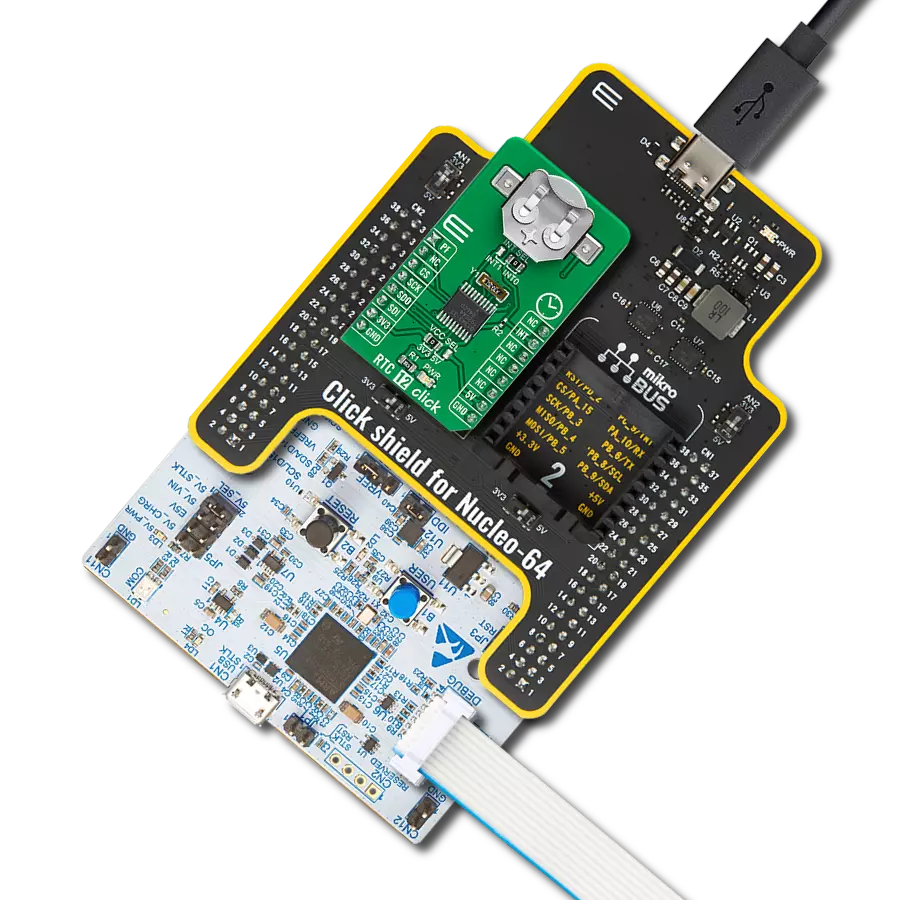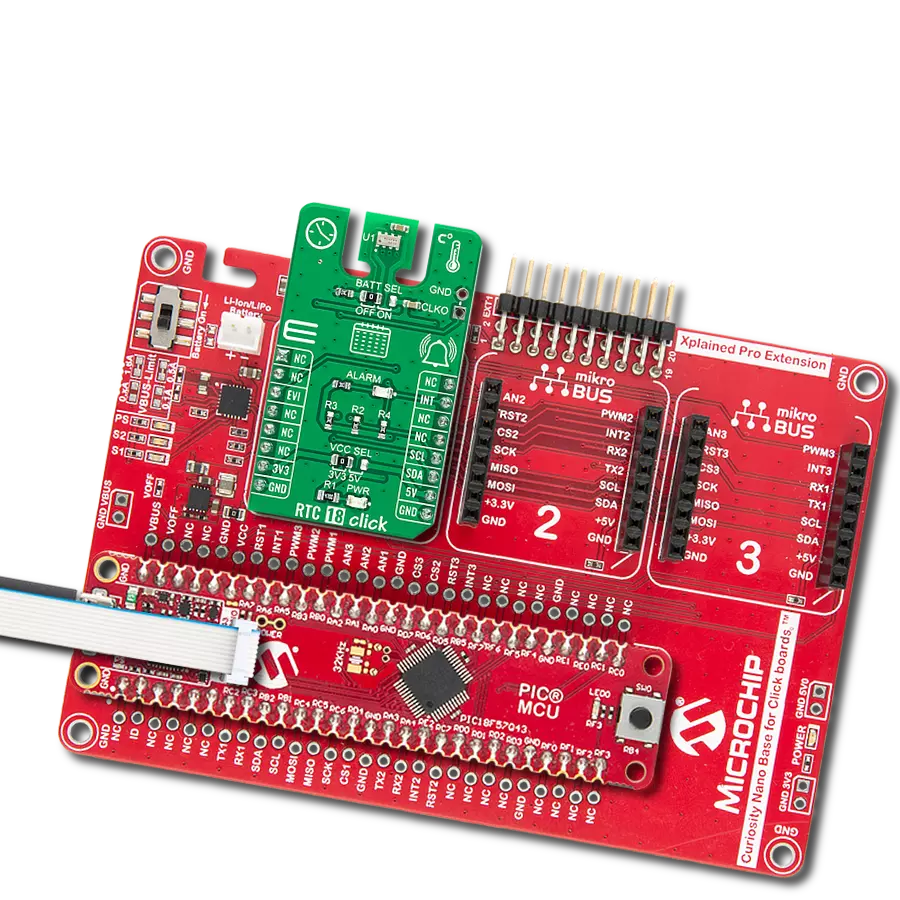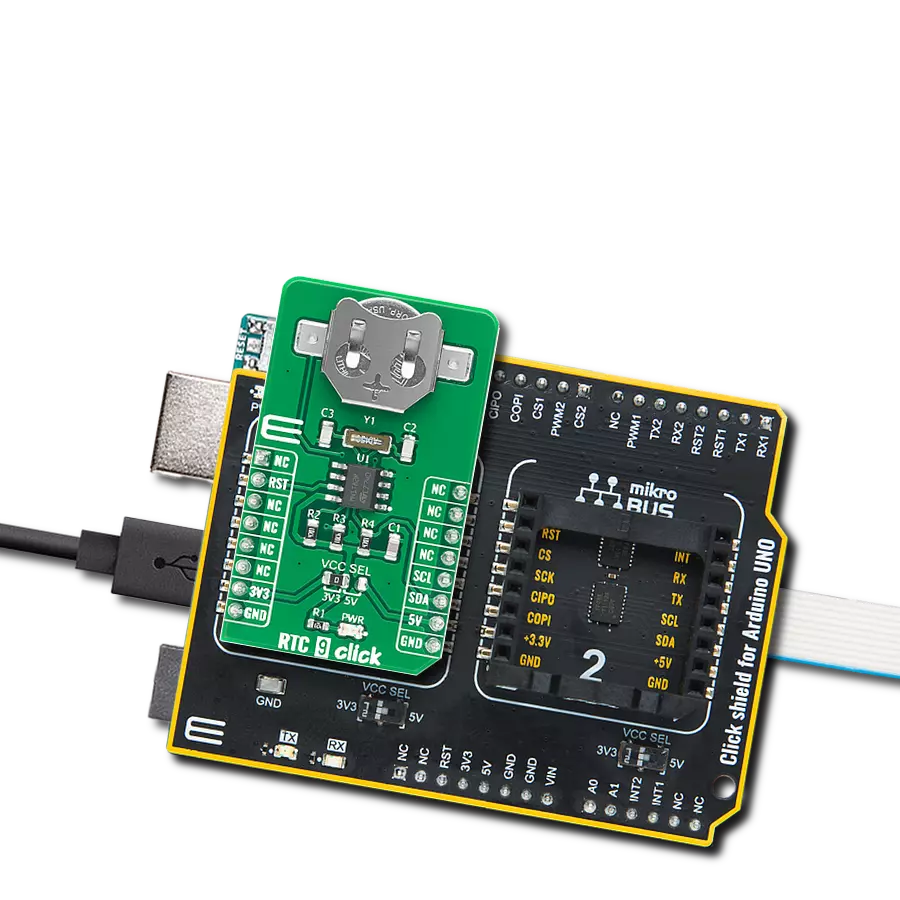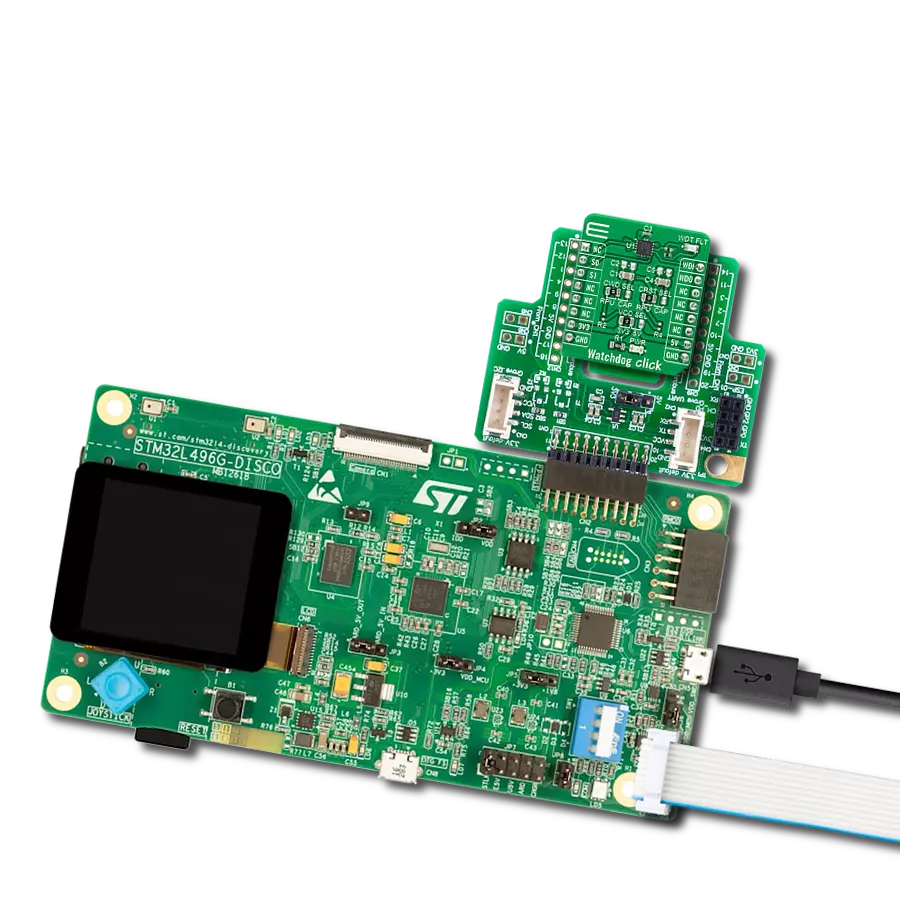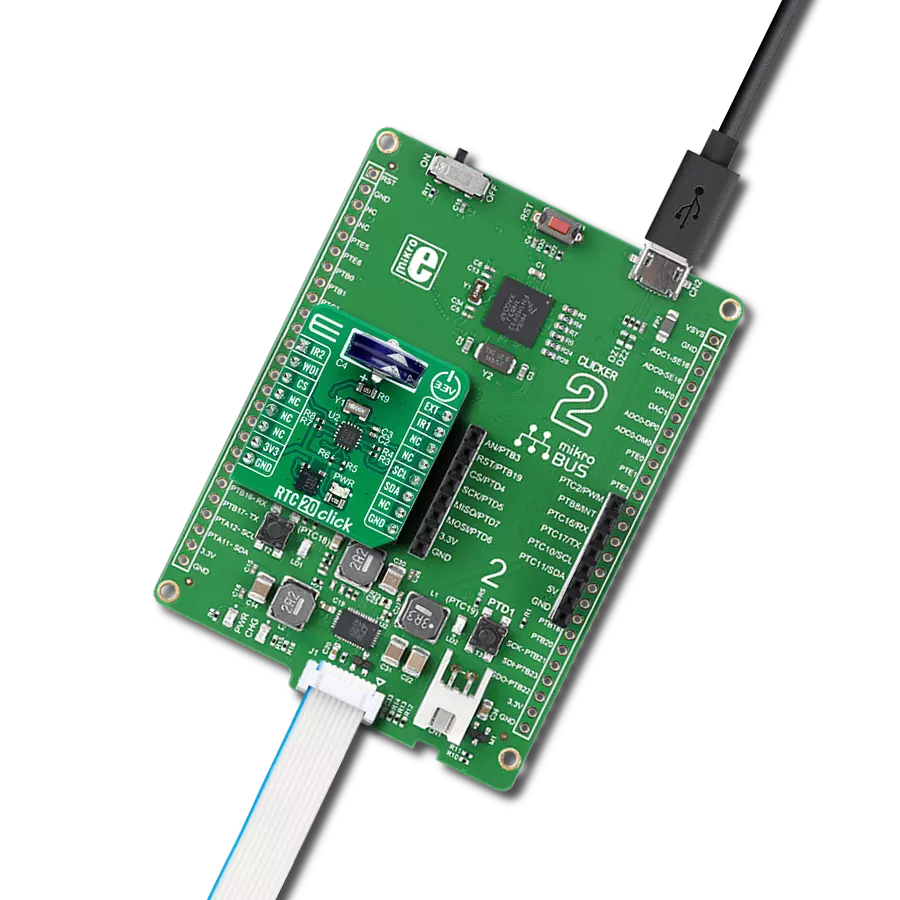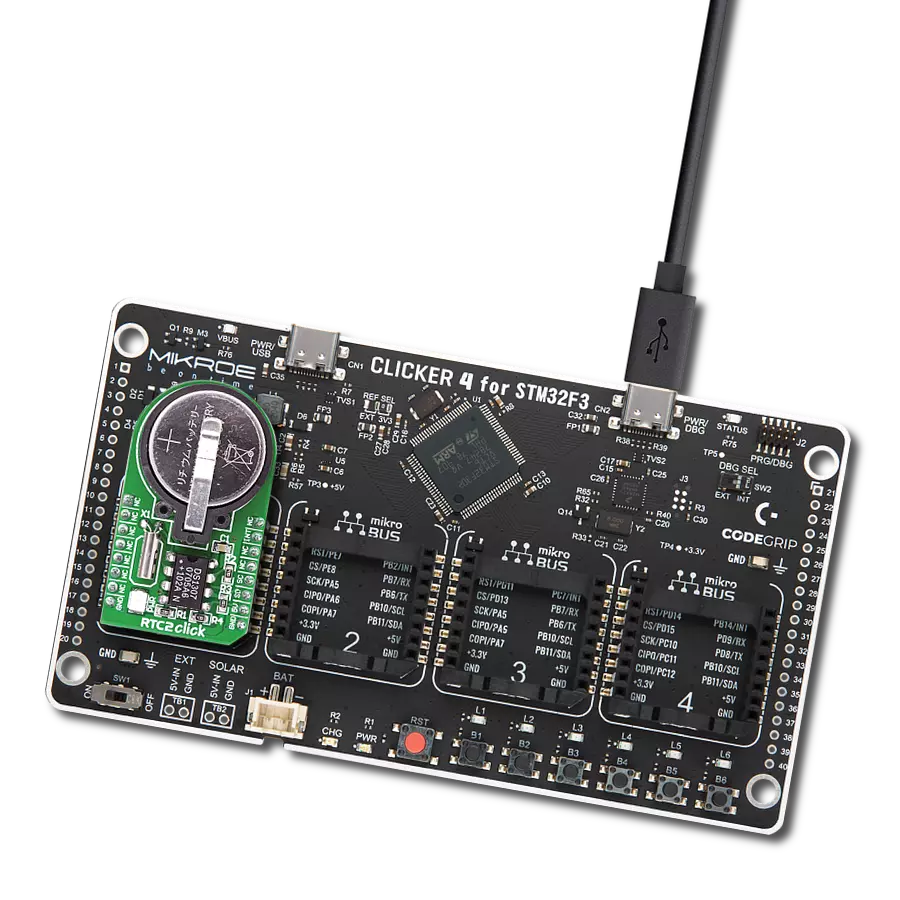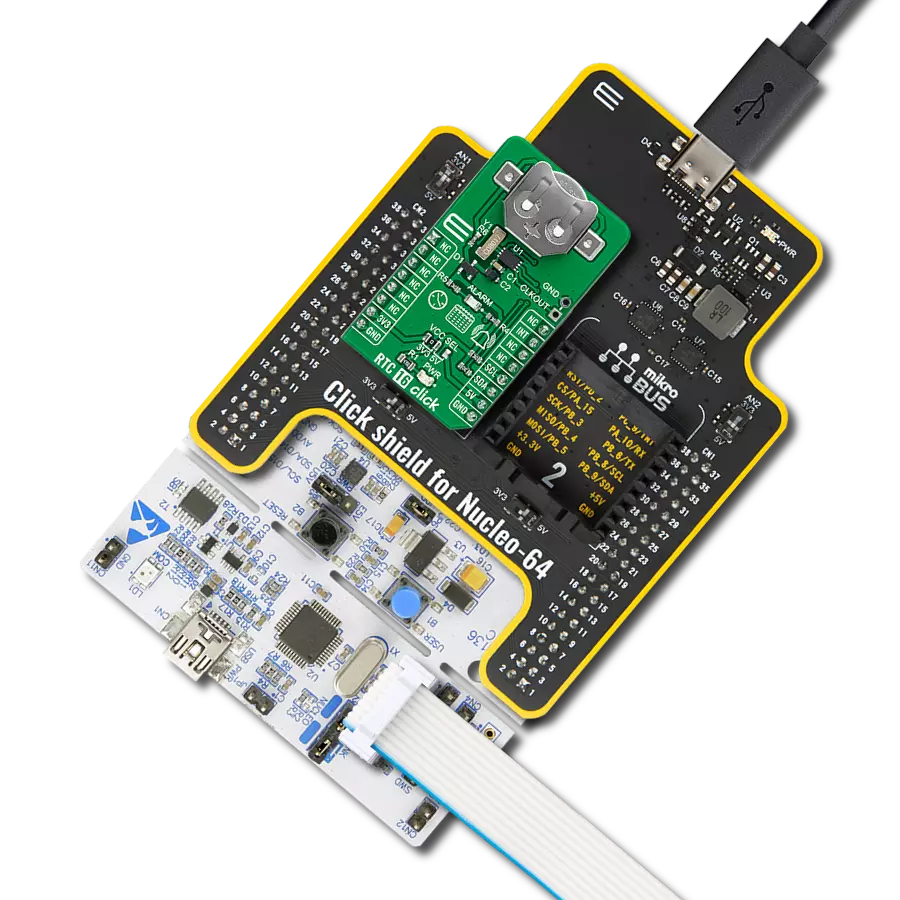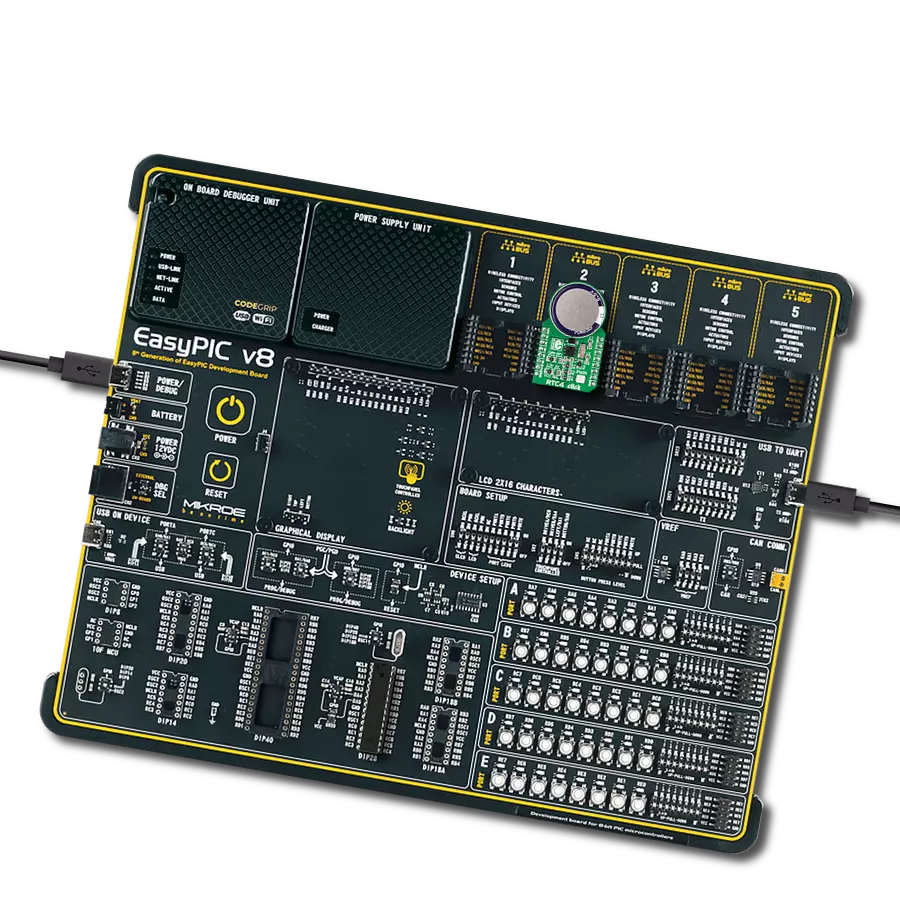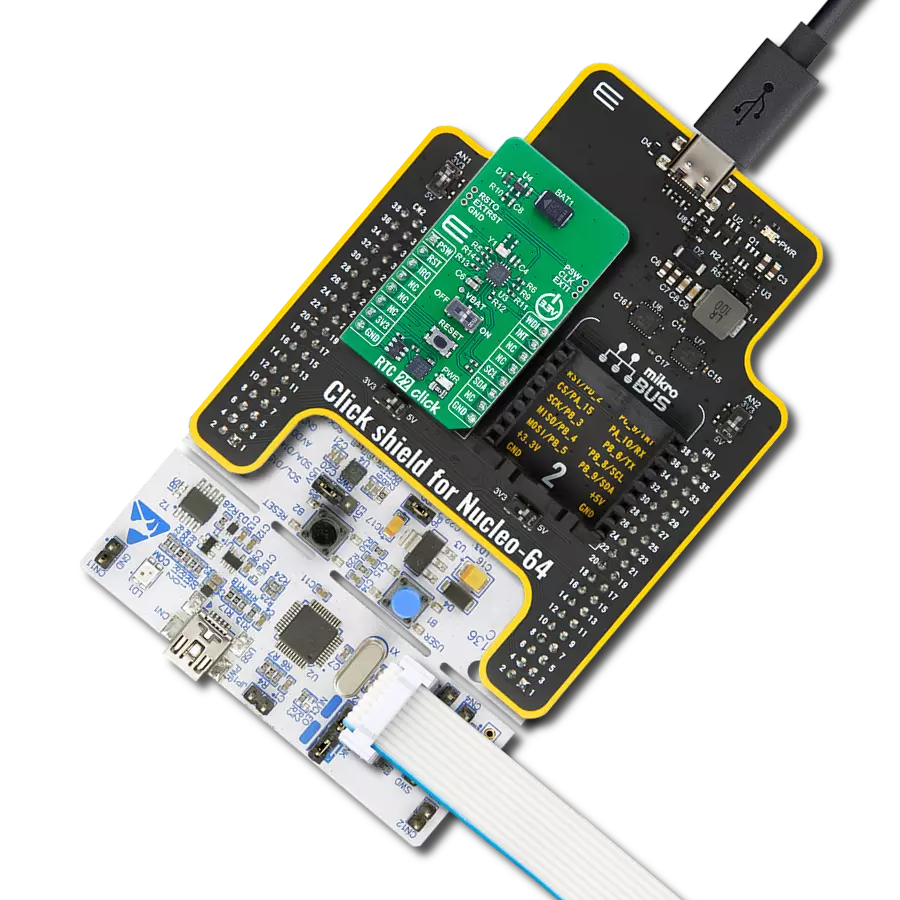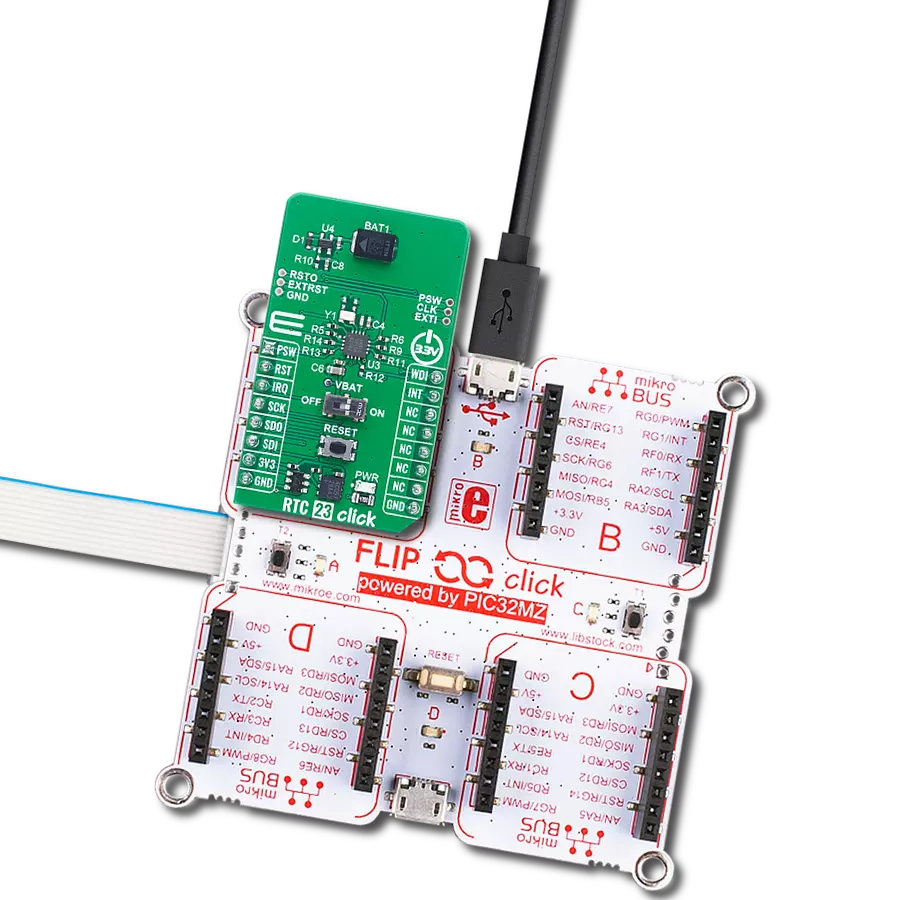Provide precise timekeeping for applications that need to track time accurately, such as data logging or scheduling tasks
A
A
Hardware Overview
How does it work?
RTC 22 Click is based on the AM1805AQ, an ultra-low-power real-time clock with integrated power management from Ambiq. Using Ambiq’s proprietary SPOT® (Subthreshold Power Optimized Technology) CMOS platform, this RTC sets a new industry standard with power consumption as low as 14nA, making it an ideal solution for power-sensitive applications. The AM1805AQ incorporates on-chip oscillators to ensure minimal power usage while providing full RTC functionality, including battery backup, programmable timers, counters, and alarms, along with an I2C interface for communication with a host MCU. Its integrated power switch and intelligent system sleep manager enable precise control over power states, allowing the RTC to be a supervisory component in MCU-based systems such as medical devices, utility meters, data loggers, household appliances, consumer electronics, and communication equipment. The AM1805AQ’s functionality is divided into baseline timekeeping, advanced timekeeping, and power management. Baseline timekeeping uses a 32.768kHz crystal oscillator, offering maximum frequency accuracy with an ultra-low current draw of just 55nA. Its digital calibration algorithm ensures frequency tuning accuracy down to 2ppm at specific temperatures. Advanced timekeeping introduces additional oscillation modes, including an RC oscillator and an auto-calibration mode, along with a finite state machine that manages host MCU transitions between active and low-power states. The integrated power switch, with an impedance of approximately 1Ω, can cut off ground current to the host MCU, reducing sleep current to below 1nA, making RTC 22 Click an essential component for any low-power embedded system. RTC 22 Click is powered from the 3.3V
mikroBUS™ power rail but also supports standalone operation, thanks to the PWY0150S micro-energy storage device from ITEN. This highly integrated, high-power-density battery delivers up to 20mA of current with a capacity of 150µAh in a compact SMD QFN package. Designed for high performance, it supports fast charging and can endure up to 1000 cycles at 100% depth of discharge (DoD). PWY0150S’s contribution to the design ensures reliable and efficient energy storage, enabling RTC 22 Click to maintain functionality even in low-power scenarios. The battery is recharged by the onboard XC6240 series charging IC for rechargeable batteries, providing a stable 2.7V charging voltage after battery depletion. Battery power can be enabled via the VBAT switch by toggling it from OFF to ON. Transitioning to standalone operation allows for significant power savings by cutting specific traces on the back of the board, which disables the lower part of the board below the RESET button, including the power indicator and ClickID circuitry. In this low-power mode, the timer interrupt signal can be used on the IRQ pin by connecting the right-side LP CUT trace on the back of the board, whereas in normal operation, this pin is reserved for ClickID communication. This Click board™ communicates with the host MCU via an I2C interface, supporting clock frequencies up to 400kHz to ensure fast and reliable data exchange. Alongside the standard I2C pins, the board includes an INT pin, an open-drain interrupt output, that signals when the RTC is ready to be accessed through the serial interface. Additionally, the WDI pin serves as a watchdog timer reset signal, safeguarding against system failures by resetting the host MCU if it becomes unresponsive, thus ensuring continuous operation.
This pin can also function as an external interrupt input, offering further flexibility for triggering specific events within the system. RTC 22 Click also features a group of unsoldered pins that provide additional functionality and flexibility. On the left side of the board, the RSTO pin serves as an open-drain reset output signal from the main AM1805AQ IC, used to reset the host MCU or other connected devices when triggered by internal RTC events, ensuring proper system initialization and recovery. Alongside it, the EXTRST pin functions as an external reset input, allowing the host MCU or external sources to reset the RTC itself when necessary. This same reset functionality is also accessible via the onboard RESET button, offering a manual alternative for triggering a system reset. On the right side, three unsoldered pins offer further capabilities: PSW acts as a power switch output for controlling external devices (also available as PSW pin on mikroBUS™ socket), turning their power supply ON or OFF; CLK provides a square-wave clock output that can serve as a precise timing reference for the host MCU or other peripherals; and EXTI functions as an external interrupt input, allowing external signals to trigger interrupts within the RTC, facilitating event-driven operations and synchronized timing in complex embedded systems. This Click board™ can be operated only with a 3.3V logic voltage level. The board must perform appropriate logic voltage level conversion before using MCUs with different logic levels. It also comes equipped with a library containing functions and example code that can be used as a reference for further development.
Features overview
Development board
Flip&Click PIC32MZ is a compact development board designed as a complete solution that brings the flexibility of add-on Click boards™ to your favorite microcontroller, making it a perfect starter kit for implementing your ideas. It comes with an onboard 32-bit PIC32MZ microcontroller, the PIC32MZ2048EFH100 from Microchip, four mikroBUS™ sockets for Click board™ connectivity, two USB connectors, LED indicators, buttons, debugger/programmer connectors, and two headers compatible with Arduino-UNO pinout. Thanks to innovative manufacturing technology,
it allows you to build gadgets with unique functionalities and features quickly. Each part of the Flip&Click PIC32MZ development kit contains the components necessary for the most efficient operation of the same board. In addition, there is the possibility of choosing the Flip&Click PIC32MZ programming method, using the chipKIT bootloader (Arduino-style development environment) or our USB HID bootloader using mikroC, mikroBasic, and mikroPascal for PIC32. This kit includes a clean and regulated power supply block through the USB Type-C (USB-C) connector. All communication
methods that mikroBUS™ itself supports are on this board, including the well-established mikroBUS™ socket, user-configurable buttons, and LED indicators. Flip&Click PIC32MZ development kit allows you to create a new application in minutes. Natively supported by Mikroe software tools, it covers many aspects of prototyping thanks to a considerable number of different Click boards™ (over a thousand boards), the number of which is growing every day.
Microcontroller Overview
MCU Card / MCU
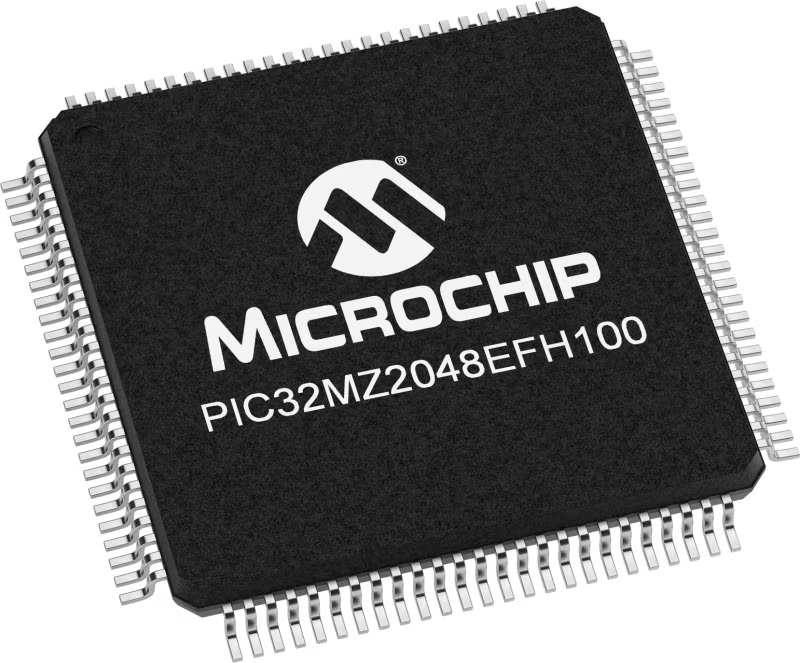
Architecture
PIC32
MCU Memory (KB)
2048
Silicon Vendor
Microchip
Pin count
100
RAM (Bytes)
524288
Used MCU Pins
mikroBUS™ mapper
Take a closer look
Click board™ Schematic
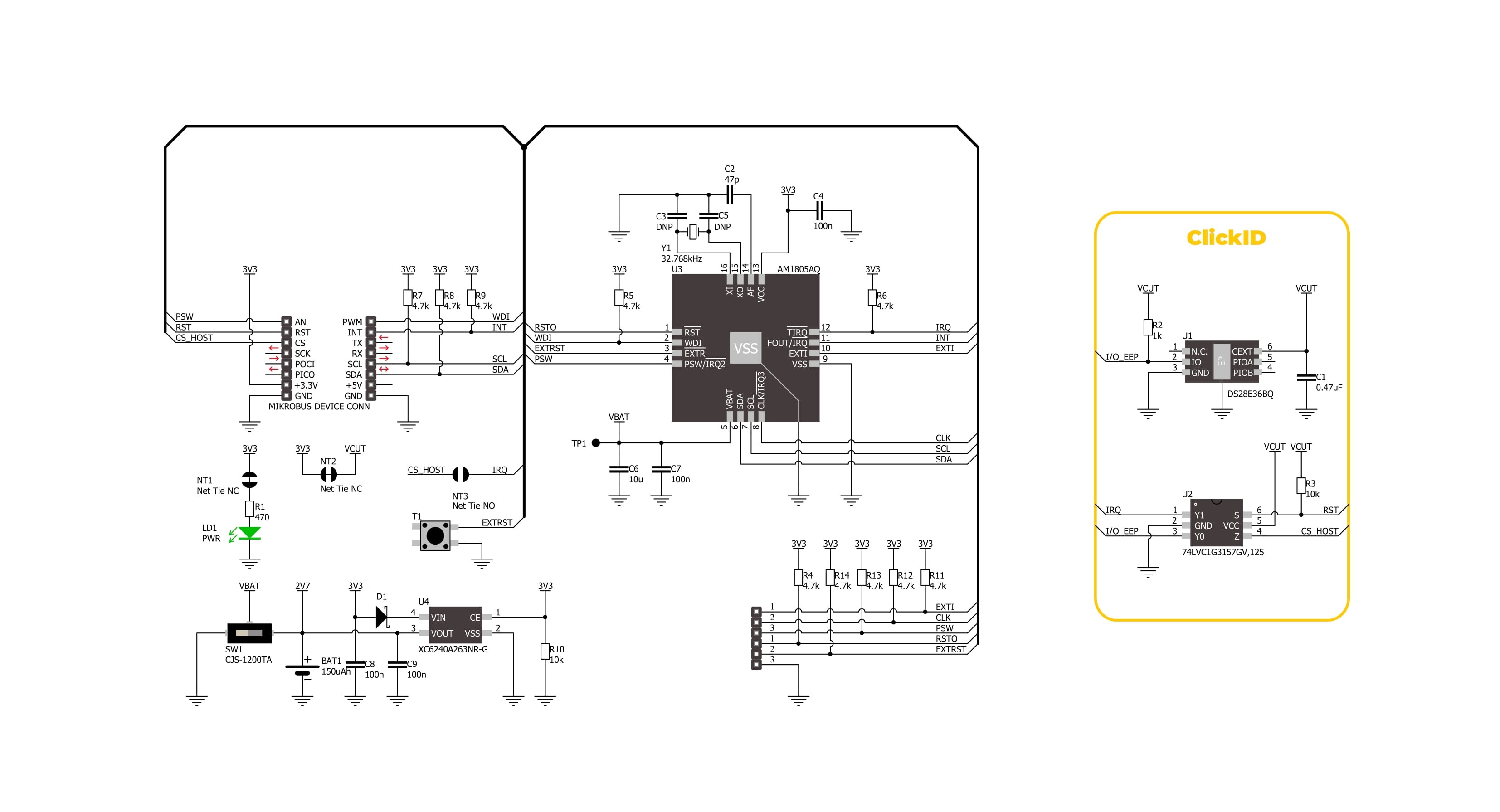
Step by step
Project assembly
Software Support
Library Description
RTC 22 Click demo application is developed using the NECTO Studio, ensuring compatibility with mikroSDK's open-source libraries and tools. Designed for plug-and-play implementation and testing, the demo is fully compatible with all development, starter, and mikromedia boards featuring a mikroBUS™ socket.
Example Description
This example demonstrates the use of RTC 22 Click by reading and displaying the time and date values.
Key functions:
rtc22_cfg_setup- Config Object Initialization function.rtc22_init- Initialization function.rtc22_set_time- This function sets the starting time values - second 100th, second, minute and hour.rtc22_read_time- This function reads the current time values - second 100th, second, minute and hour.rtc22_set_date- This function sets the starting date values - day of week, day, month and year.
Application Init
Initializes the driver, checks the communication, and sets the starting time and date.
Application Task
Reads and displays on the USB UART the current time and date values once per second.
Open Source
Code example
The complete application code and a ready-to-use project are available through the NECTO Studio Package Manager for direct installation in the NECTO Studio. The application code can also be found on the MIKROE GitHub account.
/*!
* @file main.c
* @brief RTC 22 Click example
*
* # Description
* This example demonstrates the use of RTC 22 Click board by reading and displaying
* the time and date values.
*
* The demo application is composed of two sections :
*
* ## Application Init
* Initializes the driver, checks the communication, and sets the starting time and date.
*
* ## Application Task
* Reads and displays on the USB UART the current time and date values once per second.
*
* @author Stefan Filipovic
*
*/
#include "board.h"
#include "log.h"
#include "rtc22.h"
static rtc22_t rtc22;
static log_t logger;
static rtc22_time_t time;
static rtc22_date_t date;
/**
* @brief RTC 22 get day of week name function.
* @details This function returns the name of day of the week as a string.
* @param[in] ctx : Click context object.
* See #rtc22_t object definition for detailed explanation.
* @param[in] day_of_week : Day of week decimal value.
* @return Name of day as a string.
* @note None.
*/
static uint8_t *rtc22_get_day_of_week_name ( uint8_t day_of_week );
void application_init ( void )
{
log_cfg_t log_cfg; /**< Logger config object. */
rtc22_cfg_t rtc22_cfg; /**< Click config object. */
/**
* Logger initialization.
* Default baud rate: 115200
* Default log level: LOG_LEVEL_DEBUG
* @note If USB_UART_RX and USB_UART_TX
* are defined as HAL_PIN_NC, you will
* need to define them manually for log to work.
* See @b LOG_MAP_USB_UART macro definition for detailed explanation.
*/
LOG_MAP_USB_UART( log_cfg );
log_init( &logger, &log_cfg );
log_info( &logger, " Application Init " );
// Click initialization.
rtc22_cfg_setup( &rtc22_cfg );
RTC22_MAP_MIKROBUS( rtc22_cfg, MIKROBUS_1 );
if ( I2C_MASTER_ERROR == rtc22_init( &rtc22, &rtc22_cfg ) )
{
log_error( &logger, " Communication init." );
for ( ; ; );
}
if ( RTC22_ERROR == rtc22_check_communication ( &rtc22 ) )
{
log_error( &logger, " Check communication." );
for ( ; ; );
}
time.hour = 23;
time.minute = 59;
time.second = 50;
time.second_100th = 0;
if ( RTC22_OK == rtc22_set_time ( &rtc22, &time ) )
{
log_printf( &logger, " Set time: %.2u:%.2u:%.2u\r\n",
( uint16_t ) time.hour, ( uint16_t ) time.minute, ( uint16_t ) time.second );
}
date.day_of_week = RTC22_TUESDAY;
date.day = 31;
date.month = 12;
date.year = 24;
if ( RTC22_OK == rtc22_set_date ( &rtc22, &date ) )
{
log_printf( &logger, " Set date: %s, %.2u.%.2u.20%.2u.\r\n",
rtc22_get_day_of_week_name ( date.day_of_week ),
( uint16_t ) date.day, ( uint16_t ) date.month, ( uint16_t ) date.year );
}
Delay_ms ( 100 );
log_info( &logger, " Application Task " );
}
void application_task ( void )
{
if ( RTC22_OK == rtc22_read_time ( &rtc22, &time ) )
{
log_printf( &logger, " Time: %.2u:%.2u:%.2u\r\n",
( uint16_t ) time.hour, ( uint16_t ) time.minute, ( uint16_t ) time.second );
}
if ( RTC22_OK == rtc22_read_date ( &rtc22, &date ) )
{
log_printf( &logger, " Date: %s, %.2u.%.2u.20%.2u.\r\n",
rtc22_get_day_of_week_name ( date.day_of_week ),
( uint16_t ) date.day, ( uint16_t ) date.month, ( uint16_t ) date.year );
}
Delay_ms ( 1000 );
}
int main ( void )
{
/* Do not remove this line or clock might not be set correctly. */
#ifdef PREINIT_SUPPORTED
preinit();
#endif
application_init( );
for ( ; ; )
{
application_task( );
}
return 0;
}
static uint8_t *rtc22_get_day_of_week_name ( uint8_t day_of_week )
{
switch ( day_of_week )
{
case RTC22_MONDAY:
{
return "Monday";
}
case RTC22_TUESDAY:
{
return "Tuesday";
}
case RTC22_WEDNESDAY:
{
return "Wednesday";
}
case RTC22_THURSDAY:
{
return "Thursday";
}
case RTC22_FRIDAY:
{
return "Friday";
}
case RTC22_SATURDAY:
{
return "Saturday";
}
case RTC22_SUNDAY:
{
return "Sunday";
}
default:
{
return "Unknown";
}
}
}
// ------------------------------------------------------------------------ END
Additional Support
Resources
Category:RTC


















